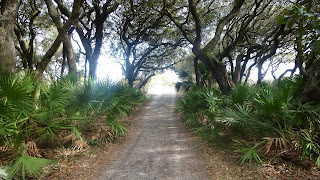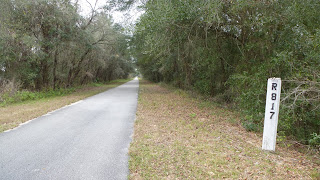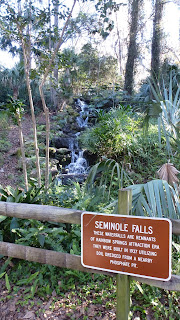The southernmost of Georgia's Golden Isles, Cumberland Island has escaped, for the most part, development which has swallowed up other Georgia islands and Amelia Island, Florida to the south. Human habitation began centuries ago. There is little or no evidence Native Americans inhabited the island more than 4000 years ago. Prior to that, shorelines would have extended farther east onto the continental shelf. In some places as many as 70 miles east in the time period going back 20,000 years, when it is generally accepted, migrations of nomadic people began coming to North America. Roughly 4000 years ago, the shorelines became stable to their present location. Little is known about the first inhabitants. there is more evidence in the period extending back 1500 years. These people were Timuruan. More specifically, the Tacatacuran tribe. Early Spanish writings reveal the existance of 6 villages on the island with the main one, Tacatacura on the southern end. Their name for the island was Wissoo, meaning Sassafras. They were mound builders and constructed mounds of shells. Pottery shards and shell middens have been found, as well as exiting mounds, mainly on the north end.
The first Europeans to arrive, came in 1513 as Ponce de Leon passed by. Later in 1562, French came and befriended the Indians. Shortly thereafter, in 1565 Governor (of La Florida) Pedro Menendez expelled the French and in 1569 built a fort and called the island "San Pedro Island". By 1587 a mission had been established and the Spanish attempted to convert the Indians. In 1597 a raid by Guale Indians destroyed the mission. In 1603, the Indians had rebuilt it and in the next century the Franciscans had two more missions on the island. Their system began to fall apart in the 1680s. Pressure from the English and raids by both French and English privateers forced the Spanish abandon. Finally in 1742 they were repulsed for good. James Oglethorpe, founder of Georgia, named the island for the Duke of Cumberland. Spanish claims to La Florida came to an end in 1763 with the Treaty of Paris. Georgia attained statehood in 1787.
After the Revolutionary War, American war hero, General National Greene of the battle of Guilford Courthouse fame, bought a huge chunk of the island. He was eyeing the Live Oak trees which were in high demand for ship building. The curving branches were used in making ship parts which needed curved timber like angled supports. He moved there with his wife Caty in 1783 and began building a huge structure. Using the mounds of shells left by the Indians, the structure was constructed of tabby, a mixture of shells, sand and mortar. Land was cleared to grow cotton. Greene's dreams were cut short upon his death in 1786. His widow later married Phineas Miller. They lived in the tabby home, named Dungeness, grew cotton, sold Live Oak timber and never got out of debt. Caty, throughout her life, attracted men. She is known to have been linked to Alexander Hamilton and Aaron Burr. How did that one end? She also became a business partner, and possibly more, with Eli Whitney, who liked the ladies as well. Caty is now credited with suggesting Eli use a comb in his famous cotton gin. The story of the cotton gin is an interesting one, worthy of another day's blog.
Phineas dies, Caty dies and Dungeness becomes the property of Caty's daughter Louisa Shaw. Close to death, one of National Greene's wartime friends, General Henry "Lighthorse" Lee (father of Robert E Lee) comes to Dungeness and is nursed by Louisa until death. I saw his grave in a small cemetery, although his body was removed in 1913, moved to Lexington Virginia.
By the Civil War, the island is almost deserted. The union uses it briefly. The 13 plantations are gone. The union soldiers are told to not destroy Dungeness but it is burned in 1862. It is blamed on "drunken debauchery".
In 1881 Thomas Carnegie, brother of Andrew, buys most of the island. He builds on the ruins of Dungeness, another Dungeness. This time in grand style as was common among the elite of the Gilded Age. He dies in 1886, leaving Dungeness to his wife Lucy Coleman Carnegie. Coleman as in Coleman camping gear. Thus, the lineage of Carnegies (now Fergusons) continue to today. They built Plum Orchard, a mansion not a grove of fruit trees; Greyfield, now an inn operated by Gogo Ferguson.
Gogo arranged John F Kennedy Jr's wedding to Carolyn Bassette in the tiny and sparce African American church on the north end of the island. It was very private and secret. Kennedy forgot his shirt and had to race back at breakneck speed via the beach to retrieve it.
Later he and Gogo proposed to the NPS, that they would finance the renovation of Plum Orchard as a artists' retreat. That proposal was rejected.
Enough of the history lesson. I arrive via the NPS ferry from St Marys Georgia. The walk to the ruins of Dungeness are nearby. Even the ruins are grand. Wild horses roam all about. The NPS doesn't really want them there. They eat cord grass and trample it, causing salt marsh erosion. No one is certain where the horses came from. They can't be linked to the Spanish, so probably, early English. The wealthy inhabitants have brought their own Arabian and other breeds which interbred with the feral houses. I think I saw a couple which looked like they had some Appaloosa genes.
The Carnegie Dungeness burned in 1959. No evidence except circumstantial has been found. The caretaker shot a poacher. The poacher survived after a hospital stay. Not long after his release, the Dungeness yacht sank and the mansion burned.
A look inside the Gilded Age
You can easily run the battery down just taking photos of the feral horses. They are everywhere. I did not see any on the beach since there is nothing for them to eat there.
After viewing the ruins, I continue to the beach, over the dunes. This stark scene is typical. Below, I pass an Osprey eating a fish. It is holding the fish on the branch and leisurely consuming it.
Now it is my lunchtime. A lone Ringbill kept me company, hoping to get a handout. Once I sent a piece his way, other Ringbills decided to join in. My buddy did his best to keep them away.
17 miles of deserted beach
After walked 2.5 miles of beach, I went inland. The NPS has several spots marked where one can cross the dunes. Little Greyfield Beach is where I crossed. From there I hiked on trails to Stafford Beach and the campground there.
Stafford Beach
Main Road
Violet Wood Sorrel
Returning via the main road was the quickest method. I needed to catch the 4:45 ferry at Sea Camp. A blister was forming so I didn't deviate much from this return route. If a vehicle had come along, many spots offered, literally, no where to get off the road. The Saw Palmetto was so thick, you could not get past it. For about an hour, no traffic passed. Then, a few cars came along but I was able to get to the side each time.
Awaiting the ferry at Sea Camp, we all gathered for the return to the mainland. I spoke with a local gal returning after preparing a local rental for group of hunters. She told me, most of the private homes had been turned over to the NPS. All the remaining have agreements of varying lengths before they too are transferred.
As the boat headed into the sun, a group of White Pelicans is spotted. A fitting end to day.























































